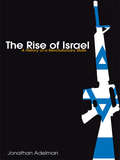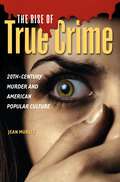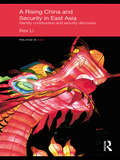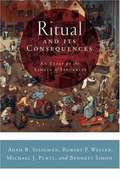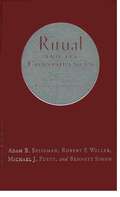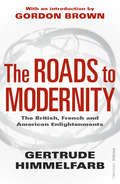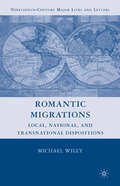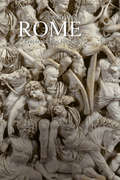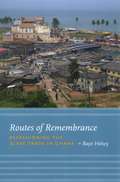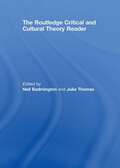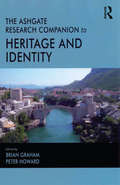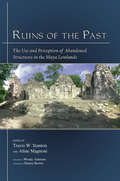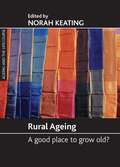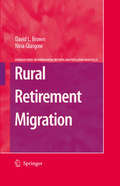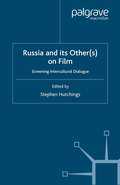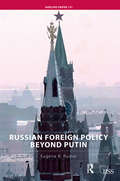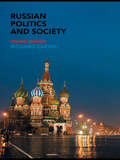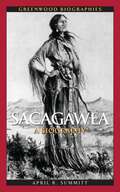- Table View
- List View
The Rise of Israel: A History of a Revolutionary State (Israeli History, Politics and Society)
by Jonathan AdelmanThe state of Israel is one of the most controversial countries in the world. Yet, its unique creation and rise to power in 1948 has not been adequately explained either by its friends (mainstream Zionists) nor by its detractors (Arabists and post-Zionists). Using a variety of comparative methodologies; from contrasting the Jewish state to other minorities in the Ottoman Turkish Empire to the rise of the four Tigers in Asia to newly independent countries and revolutionary socialist countries in Europe and Asia, Jonathan Adelman examines how Israel has gained the strength to overcome great obstacles and become a serious regional power in the Middle East by 2007. Themes addressed include: how the creation of Israel is strikingly different from that of most new states, as undetermined by the major structural forces in the world in the twentieth century how voluntarist forces, those of individual choice, will and strategy, played a major role in its creation and success in-depth analysis of the creation of a revolutionary party, government, army and secret police as critical to the success of the socialist revolution (1881–1977) the enormity of the forces aligned against the state; from major international and religious organizations representing billions of people, international reluctance to helping Israel in crisis, and internal Israeli and Jewish issues the tremendous impact of revolutionary (socialist and semi-capitalist nationalist) factors in giving Israel the strength to survive and become a significant regional power over time. Jonathan Adelman provides a fresh perspective to view one of the most controversial states in the world and avoids the highly charged ideological descriptions that often plague such discussions. Understanding the rise of Israel, a central state in the region, helps to explain a great deal about the Middle East today.
The Rise of True Crime: 20th-Century Murder and American Popular Culture
by Jean MurleyDuring the 1950s and 1960s True Detective magazine developed a new way of narrating and understanding murder. It was more sensitive to context, gave more psychologically sophisticated accounts, and was more willing to make conjectures about the unknown thoughts and motivations of killers than others had been before. This turned out to be the start of a revolution, and, after a century of escalating accounts, we have now become a nation of experts, with many ordinary people able to speak intelligently about blood-spatter patterns and organized vs. disorganized serial killers. The Rise of True Crime examines the various genres of true crime using the most popular and well-known examples. And despite its examination of some of the potentially negative effects of the genre, it is written for people who read and enjoy true crime, and wish to learn more about it.With skyrocketing crime rates and the appearance of a frightening trend toward social chaos in the 1970s, books, documentaries, and fiction films in the true crime genre tried to make sense of the Charles Manson crimes and the Gary Gilmore execution events. And in the 1980s and 1990s, true crime taught pop culture consumers about forensics, profiling, and highly technical aspects of criminology. We have thus now become a nation of experts, with many ordinary people able to speak intelligently about blood-spatter patterns and organized vs. disorganized serial killers.Through the suggestion that certain kinds of killers are monstrous or outside the realm of human morality, and through the perpetuation of the stranger-danger idea, the true crime aesthetic has both responded to and fostered our culture's fears. True crime is also the site of a dramatic confrontation with the concept of evil, and one of the few places in American public discourse where moral terms are used without any irony, and notions and definitions of evil are presented without ambiguity. When seen within its historical context, true crime emerges as a vibrant and meaningful strand of popular culture, one that is unfortunately devalued as lurid and meaningless pulp.
A Rising China and Security in East Asia: Identity Construction and Security Discourse (Politics in Asia)
by Rex LiThis volume provides a comprehensive and in-depth analysis of the security discourse of Chinese policy elites on the major powers in East Asia in relation to China’s self-perception as a rising power. It is the first book-length study that utilizes International Relations theories systematically to analyze Chinese security perceptions of the United States, Japan and Russia, and the debate among Chinese international relations specialists on how China should respond to the perceived challenge from the major powers to its rise to a global status. Rex Li argues that the security discourse of Chinese policy analysts is closely linked to their conception of China’s identity and their desire and endeavour to construct a great power identity for China. Drawing on extensive and up-to-date Chinese-language sources, the study demonstrates that Chinese elites perceive the power, aspirations and security strategies of other East Asian powers primarily in terms of their implications for China’s pursuit of great power status. This new work will contribute significantly to the on-going academic and policy debate on the nature and repercussions of China’s rise. This book will be essential reading for undergraduate and postgraduate students and scholars of Asian security, China’s foreign relations, security studies and international relations.
A Rising China and Security in East Asia: Identity Construction and Security Discourse (Politics in Asia)
by Rex LiThis volume provides a comprehensive and in-depth analysis of the security discourse of Chinese policy elites on the major powers in East Asia in relation to China’s self-perception as a rising power. It is the first book-length study that utilizes International Relations theories systematically to analyze Chinese security perceptions of the United States, Japan and Russia, and the debate among Chinese international relations specialists on how China should respond to the perceived challenge from the major powers to its rise to a global status. Rex Li argues that the security discourse of Chinese policy analysts is closely linked to their conception of China’s identity and their desire and endeavour to construct a great power identity for China. Drawing on extensive and up-to-date Chinese-language sources, the study demonstrates that Chinese elites perceive the power, aspirations and security strategies of other East Asian powers primarily in terms of their implications for China’s pursuit of great power status. This new work will contribute significantly to the on-going academic and policy debate on the nature and repercussions of China’s rise. This book will be essential reading for undergraduate and postgraduate students and scholars of Asian security, China’s foreign relations, security studies and international relations.
Ritual And Its Consequences: An Essay On The Limits Of Sincerity (PDF)
by Bennett Simon Adam Seligman Robert Weller Michael PuettThis pioneering, interdisciplinary work shows how rituals allow us to live in a perennially imperfect world. Drawing on a variety of cultural settings, the authors utilize psychoanalytic and anthropological perspectives to describe how ritual--like play--creates "as if" worlds, rooted in theimaginative capacity of the human mind to create a subjunctive universe. The ability to cross between imagined worlds is central to the human capacity for empathy. Ritual, they claim, defines the boundaries of these imagined worlds, including those of empathy and other realms of human creativity,such as music, architecture and literature. The authors juxtapose this ritual orientation to a "sincere" search for unity and wholeness. The sincere world sees fragmentation and incoherence as signs of inauthenticity that must be overcome. Our modern world has accepted the sincere viewpoint at the expense of ritual,dismissing ritual asmere convention. In response, the authors show how the conventions of ritual allow us to live together in a broken world. Ritual is work, endless work. But it is among the most important things that we humans do.
Ritual and Its Consequences: An Essay on the Limits of Sincerity
by Simon Adam B. Seligman Robert P. Weller Michael JThis pioneering, interdisciplinary work shows how rituals allow us to live in a perennially imperfect world. Drawing on a variety of cultural settings, the authors utilize psychoanalytic and anthropological perspectives to describe how ritual--like play--creates "as if" worlds, rooted in the imaginative capacity of the human mind to create a subjunctive universe. The ability to cross between imagined worlds is central to the human capacity for empathy. Ritual, they claim, defines the boundaries of these imagined worlds, including those of empathy and other realms of human creativity, such as music, architecture and literature. The authors juxtapose this ritual orientation to a "sincere" search for unity and wholeness. The sincere world sees fragmentation and incoherence as signs of inauthenticity that must be overcome. Our modern world has accepted the sincere viewpoint at the expense of ritual, dismissing ritual as mere convention. In response, the authors show how the conventions of ritual allow us to live together in a broken world. Ritual is work, endless work. But it is among the most important things that we humans do.
The Roads to Modernity: The British, French and American Enlightenments
by Gertrude Himmelfarb Gordon BrownGertrude Himmelfarb's elegant and wonderfully readable work, The Roads to Modernity, reclaims the Enlightenment from historians who have downgraded its importance and from scholars who have given preeminence to the Enlightenment in France over concurrent movements in England and in America.Himmerlfarb demonstrates the primacy and wisdom of the British, exemplified in such thinkers as Adam Smith, David Hume, and Edmund Burke, as well as the unique and enduring contributions of the American Founders. It is their Enlightenments, she argues, that created a social ethic - humane, compassionate and realistic - that still resonates strongly today.
Romantic Migrations: Local, National, and Transnational Dispositions (Nineteenth-Century Major Lives and Letters)
by M. WileyAnalyzing real, speculative, and imaginary schemes of migration to and from Britain, this book addresses three interrelated movements: between France and Britain after the French Revolution, between Britain and North America also after the Revolution, and between West Africa and Britain in the years leading to the Revolution.
Rome: Empire of the Eagles, 753 BC – AD 476
by Neil FaulknerThe Roman Empire is widely admired as a model of civilisation. In this compelling new study Neil Faulkner argues that in fact, it was nothing more than a ruthless system of robbery and violence. War was used to enrich the state, the imperial ruling classes and favoured client groups. In the process millions of people were killed or enslaved. Within the empire the landowning elite creamed off the wealth of the countryside to pay taxes to the state and fund the towns and villas where they lived. The masses of people - slaves, serfs and poor peasants - were victims of a grand exploitation that made the empire possible. This system, riddled with tension and latent conflict, contained the seeds of its own eventual collapse.
Rome: Empire of the Eagles, 753 BC – AD 476
by Neil FaulknerThe Roman Empire is widely admired as a model of civilisation. In this compelling new study Neil Faulkner argues that in fact, it was nothing more than a ruthless system of robbery and violence. War was used to enrich the state, the imperial ruling classes and favoured client groups. In the process millions of people were killed or enslaved. Within the empire the landowning elite creamed off the wealth of the countryside to pay taxes to the state and fund the towns and villas where they lived. The masses of people - slaves, serfs and poor peasants - were victims of a grand exploitation that made the empire possible. This system, riddled with tension and latent conflict, contained the seeds of its own eventual collapse.
Routes of Remembrance: Refashioning the Slave Trade in Ghana
by Bayo HolseyOver the past fifteen years, visitors from the African diaspora have flocked to Cape Coast and Elmina, two towns in Ghana whose chief tourist attractions are the castles and dungeons where slaves were imprisoned before embarking for the New World. This desire to commemorate the Middle Passage contrasts sharply with the silence that normally cloaks the subject within Ghana. Why do Ghanaians suppress the history of enslavement? And why is this history expressed so differently on the other side of the Atlantic? Routes of Remembrance tackles these questions by analyzing the slave trade’s absence from public versions of coastal Ghanaian family and community histories, its troubled presentation in the country’s classrooms and nationalist narratives, and its elaboration by the transnational tourism industry. Bayo Holsey discovers that in the past, African involvement in the slave trade was used by Europeans to denigrate local residents, and this stigma continues to shape the way Ghanaians imagine their historical past. Today, however, due to international attention and the curiosity of young Ghanaians, the slave trade has at last entered the public sphere, transforming it from a stigmatizing history to one that holds the potential to contest global inequalities. Holsey’s study will be crucial to anyone involved in the global debate over how the slave trade endures in history and in memory.
Routes of Remembrance: Refashioning the Slave Trade in Ghana
by Bayo HolseyOver the past fifteen years, visitors from the African diaspora have flocked to Cape Coast and Elmina, two towns in Ghana whose chief tourist attractions are the castles and dungeons where slaves were imprisoned before embarking for the New World. This desire to commemorate the Middle Passage contrasts sharply with the silence that normally cloaks the subject within Ghana. Why do Ghanaians suppress the history of enslavement? And why is this history expressed so differently on the other side of the Atlantic? Routes of Remembrance tackles these questions by analyzing the slave trade’s absence from public versions of coastal Ghanaian family and community histories, its troubled presentation in the country’s classrooms and nationalist narratives, and its elaboration by the transnational tourism industry. Bayo Holsey discovers that in the past, African involvement in the slave trade was used by Europeans to denigrate local residents, and this stigma continues to shape the way Ghanaians imagine their historical past. Today, however, due to international attention and the curiosity of young Ghanaians, the slave trade has at last entered the public sphere, transforming it from a stigmatizing history to one that holds the potential to contest global inequalities. Holsey’s study will be crucial to anyone involved in the global debate over how the slave trade endures in history and in memory.
Routes of Remembrance: Refashioning the Slave Trade in Ghana
by Bayo HolseyOver the past fifteen years, visitors from the African diaspora have flocked to Cape Coast and Elmina, two towns in Ghana whose chief tourist attractions are the castles and dungeons where slaves were imprisoned before embarking for the New World. This desire to commemorate the Middle Passage contrasts sharply with the silence that normally cloaks the subject within Ghana. Why do Ghanaians suppress the history of enslavement? And why is this history expressed so differently on the other side of the Atlantic? Routes of Remembrance tackles these questions by analyzing the slave trade’s absence from public versions of coastal Ghanaian family and community histories, its troubled presentation in the country’s classrooms and nationalist narratives, and its elaboration by the transnational tourism industry. Bayo Holsey discovers that in the past, African involvement in the slave trade was used by Europeans to denigrate local residents, and this stigma continues to shape the way Ghanaians imagine their historical past. Today, however, due to international attention and the curiosity of young Ghanaians, the slave trade has at last entered the public sphere, transforming it from a stigmatizing history to one that holds the potential to contest global inequalities. Holsey’s study will be crucial to anyone involved in the global debate over how the slave trade endures in history and in memory.
The Routledge Critical and Cultural Theory Reader (PDF)
by Neil Badmington Julia ThomasEverything is open to question. Nothing is sacred. Critical and cultural theory invites a rethinking of some of our most basic assumptions about who we are, how we behave, and how we interpret the world around us. The Routledge Critical and Cultural Theory Reader brings together 29 key pieces from the last century and a half that have shaped the field. Topics include: subjectivity, language, gender, ethnicity, sexuality, the body, the human, class, culture, everyday life, literature, psychoanalysis, technology, power, and visuality. The choice of texts, together with the editors' introduction and glossary, will allow newcomers to begin from first principles, while the use of unabridged readings will also make the volume suitable for those undertaking more specialized work. Material is arranged chronologically, but the editors have suggested thematic pathways through the selections.
The Routledge Research Companion to Heritage and Identity
by Peter HowardHeritage represents the meanings and representations conveyed in the present day upon artifacts, landscapes, mythologies, memories and traditions from the past. It is a key element in the shaping of identities, particularly in the context of increasingly multicultural societies. This Research Companion brings together an international team of authors to discuss the concepts, ideas and practices that inform the entwining of heritage and identity. They have assembled a wide geographical range of examples and interpret them through a number of disciplinary lenses that include geography, history, museum and heritage studies, archaeology, art history, history, anthropology and media studies. This outstanding companion offers scholars and graduate students a thoroughly up-to-date guide to current thinking and a comprehensive reference to this growing field.
The Routledge Research Companion to Heritage and Identity
by Peter HowardHeritage represents the meanings and representations conveyed in the present day upon artifacts, landscapes, mythologies, memories and traditions from the past. It is a key element in the shaping of identities, particularly in the context of increasingly multicultural societies. This Research Companion brings together an international team of authors to discuss the concepts, ideas and practices that inform the entwining of heritage and identity. They have assembled a wide geographical range of examples and interpret them through a number of disciplinary lenses that include geography, history, museum and heritage studies, archaeology, art history, history, anthropology and media studies. This outstanding companion offers scholars and graduate students a thoroughly up-to-date guide to current thinking and a comprehensive reference to this growing field.
Ruins of the Past: The Use and Perception of Abandoned Structures in the Maya Lowlands (Mesoamerican Worlds Ser.)
by Travis W. Stanton Aline MagnoniFrom the Preclassic to the present, Maya peoples have continuously built, altered, abandoned, and re-used structures, imbuing them with new meanings at each transformation. Ruins of the Past is the first volume to focus on how previously built structures in the Maya Lowlands were used and perceived by later peoples, exploring the topic through concepts of landscape, place, and memory. The collection, as Wendy Ashmore points out in her foreword, offers "a stimulating, productive, and fresh set of inferences about ancient Maya cognition of their own past." Contributors include Anthony P. Andrews, Ana Lucía Arroyave Prera, Antonio Benavides C., M. Kathryn Brown, Marcello A. Canuto, Mark B. Child, David A. Freidel, James F. Garber, Charles W. Golden, Stanley P. Guenter, Jon B. Hageman, Richard D. Hansen, Brett A. Houk, Wayne K. Howell, Paul Hughbanks, Scott R. Hutson, Aline Magnoni, T. Kam Manahan, Olivia C. Navarro Farr, Travis W. Stanton, Lauren A. Sullivan, and Fred Valdez Jr.
Rural ageing: A good place to grow old? (Ageing and the Lifecourse series)
by Norah C KeatingThis important book addresses a growing international interest in 'age-friendly' communities. It examines the conflicting stereotypes of rural communities as either idyllic and supportive or isolated and bereft of services. Providing detailed information on the characteristics of rural communities, contributors ask the question, 'good places for whom'? The book extends our understanding of the intersections of rural people and places across the adult lifecourse. Taking a critical human ecology perspective, authors trace lifecourse changes in community and voluntary engagement and in the availability of social support. They illustrate diversity among older adults in social inclusion and in the types of services that are essential to their well being. For the first time, detailed information is provided on characteristics of rural communities that make them supportive to different groups of older adults. Comparisons between the UK and North America highlight similarities in how landscapes create rural identities, and fundamental differences in how climate, distance and rural culture shape the everyday lives of older adults. Rural ageing is a valuable resource for students, academics and practitioners interested in communities, rural settings and ageing and the lifecourse. Rich in national profiles and grounded in the narratives of older adults, it provides theoretical, empirical and practical examples of growing old in rural communities never before presented.
Rural Retirement Migration (The Springer Series on Demographic Methods and Population Analysis #21)
by David L. Brown Nina GlasgowThis fascinating book examines rural retirement migration from the older in-migrants’ perspective and from the vantage point of the destination communities to which they move. This integrated approach permits the authors to view older in-migrants as embedded in environments that facilitate and/or constrain their opportunities for productive living during older age. It also permits the examination of positive and negative effects of older in-migration for destination communities.
Russia and its Other: Screening Intercultural Dialogue (Studies in Central and Eastern Europe)
by S. HutchingsRussia's interactions with the West have been a perennial theme of Slavic Studies, and of Russian culture and politics. Likewise, representations of Russia have shaped the identities of many western cultures. No longer providing the 'Evil Empire' of 20th American popular consciousness, images of Russia have more recently bifurcated along two streams: that of the impoverished refugee and that of the sinister mafia gang. Focusing on film as an engine of intercultural communication, this is the first book to explore mutual perceptions of the foreign Other in the cinema of Russia and the West during, and after, communism. The book's structure reflects both sides of this fascinating dialogue: Part 1 covers Russian/Soviet cinematic representations of otherness, and Part 2 treats western representations of Russia and the Soviet Union. An extensive Introduction sets the dialogue in a theoretical context. The contributors include leading film scholars from the USA, Europe and Russia.
Russian Foreign Policy Beyond Putin
by Eugene B. RumerRussia‘s resurgence as an assertive actor in the global diplomatic arena after a long period of introspection and preoccupation with domestic troubles, and the economic revival that underpins it, are among the most striking developments in international relations of recent years. But what drives Russian foreign policy at the end of the Putin era? To what extent is it shaped by Russia‘s role as a major energy supplier, and how long can the country remain anenergy superpower if indeed it is one? How might Russian foreign policy change in the years ahead? Which way will Russia, faced with the might of growing powers around it, and struggling with the fragility of its economic success and stability at home, choose to face in international relations? This Adelphi Paper examines the domestic context of contemporary Russian foreign policy and its key political, economic, military and security drivers, as well as looking at the contrasting outlook that preceded it, and at how Russia‘s international posture may adjust again in the coming years. It concludes with recommendations for Western policy makers on how to respond to Russia‘s return.
Russian Foreign Policy Beyond Putin (Adelphi Ser.)
by Eugene B. RumerRussia‘s resurgence as an assertive actor in the global diplomatic arena after a long period of introspection and preoccupation with domestic troubles, and the economic revival that underpins it, are among the most striking developments in international relations of recent years. But what drives Russian foreign policy at the end of the Putin era? To what extent is it shaped by Russia‘s role as a major energy supplier, and how long can the country remain anenergy superpower if indeed it is one? How might Russian foreign policy change in the years ahead? Which way will Russia, faced with the might of growing powers around it, and struggling with the fragility of its economic success and stability at home, choose to face in international relations? This Adelphi Paper examines the domestic context of contemporary Russian foreign policy and its key political, economic, military and security drivers, as well as looking at the contrasting outlook that preceded it, and at how Russia‘s international posture may adjust again in the coming years. It concludes with recommendations for Western policy makers on how to respond to Russia‘s return.
Russian Politics and Society
by Richard SakwaHaving been fully revised and updated to reflect the considerable changes in Russia over the last decade, the fourth edition of this classic text builds on the strengths of the previous editions to provide a comprehensive and sophisticated analysis on Russian politics and society. New to this edition: extended coverage of electoral laws, party development and regional politics new chapter on the ‘phoney democracy’ period, 1991-93 historical evaluation of Yeltsin’s leadership full coverage of Putin’s presidency discussion of the development of civil society and the problems of democratic consolidation latest developments in the Chechnya conflict more on foreign policy issues the re-introduction of the Russian Constitution as an appendix an updated Select Bibliography more focus on the challenges facing Russia in the twenty-first century. Written in an accessible and lively style, this book is packed with detailed information on the central debates and issues in Russia’s difficult transformation. This makes it the best available textbook on the subject and is essential reading for all those concerned with the fate of Russia, and with the future of international society.
Russian Politics and Society
by Richard SakwaHaving been fully revised and updated to reflect the considerable changes in Russia over the last decade, the fourth edition of this classic text builds on the strengths of the previous editions to provide a comprehensive and sophisticated analysis on Russian politics and society. New to this edition: extended coverage of electoral laws, party development and regional politics new chapter on the ‘phoney democracy’ period, 1991-93 historical evaluation of Yeltsin’s leadership full coverage of Putin’s presidency discussion of the development of civil society and the problems of democratic consolidation latest developments in the Chechnya conflict more on foreign policy issues the re-introduction of the Russian Constitution as an appendix an updated Select Bibliography more focus on the challenges facing Russia in the twenty-first century. Written in an accessible and lively style, this book is packed with detailed information on the central debates and issues in Russia’s difficult transformation. This makes it the best available textbook on the subject and is essential reading for all those concerned with the fate of Russia, and with the future of international society.
Sacagawea: A Biography (Greenwood Biographies)
by April R. SummittSacagawea, kidnapped as an adolescent and sold as a slave to a French-Canadian fur trader, is best known for her role as interpreter and symbol of goodwill for Lewis and Clark on their journey west. Despite her pivotal role in this era of Manifest Destiny and blending cultures, much of her ensuing life story remains uncertain, thanks to a larger focus on Lewis and Clark themselves, as well as the perpetuation of legend over fact in several 20th century movies and publications. This concise and readable biography offers an objective treatment of Sacagawea's childhood, her journey with Lewis and Clark, her later life, her explorer son, and the mythology surrounding her death and legacy. As the Lewis and Clark expedition is heavily represented in the U.S. history curriculum, this much-needed volume fills a gap on the reference shelves and supplements American history and Native American studies curricula. Lively narrative chapters are supplemented with a timeline, photos, print and nonprint bibliography, and an index.As the Lewis and Clark expedition is heavily represented in the U.S. history curriculum, this much-needed volume fills a gap on the reference shelves and supplements Native American studies curricula. The subject matter directly supports the National Standards for U.S. history Era 4: Expansion and Reform (1801-1861). Lively narrative chapters are supplemented with a timeline, photos, print and nonprint bibliography, and an index.
